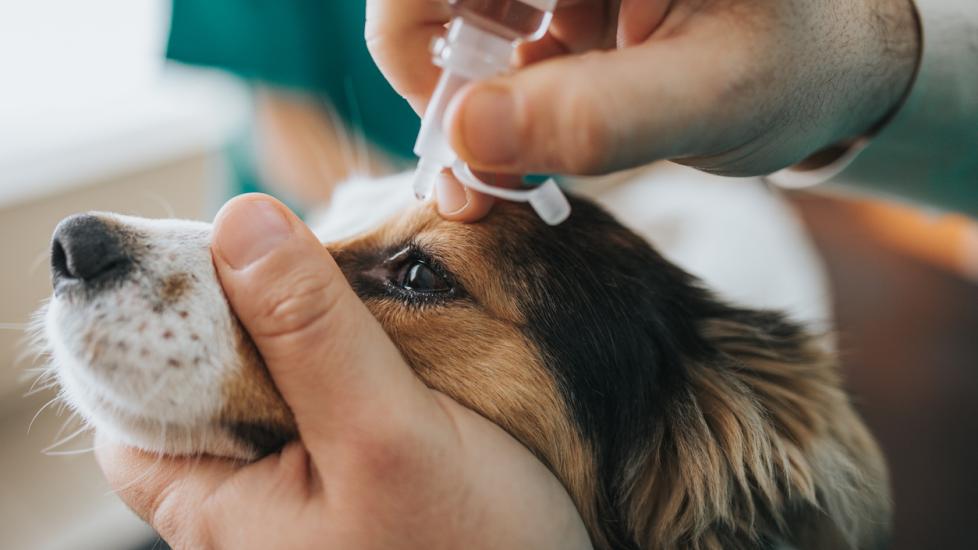How To Give a Dog or Cat Eye Drops
The following may contain Chewy links. PetMD is operated by Chewy.
When your pet is diagnosed with an eye condition, it can be an overwhelming experience. You may have multiple medications to give at different times of day—and a pet that is not exactly a willing participant in the situation. But when it comes to giving eye drops to your cat or dog, there are ways to make the process go more smoothly.
When Do Pets Need Eye Drops?
Many different health concerns may cause a dog or cat to need eye medications. There are certain common dog eye problems or cat eye problems that may call for topical treatments, including:
-
Infections
-
Abrasions
-
Ulcers
-
Glaucoma
-
Dry eye
Some conditions may be temporary, but others may require lifelong care with drops, ointments, or other cat or dog eye medicine. Your veterinarian will take several things into consideration when deciding what medication to use for your pet’s eye issue, including:
-
Availability of the medication
-
Type of medication needed
-
Frequency at which it needs to be administered
-
Your pet’s temperament
-
The issue being treated
Eye Drops vs. Ointments
There are two main types of eye medications your pet may be prescribed: ointments and drops. An ointment, which is a thicker medication, can be more difficult to apply. Ointments will also cause blurred vision for a short period of time after application, but they will stay in the eye for a longer period to allow the medication more time to do its job. Drops are thinner, so they won’t stay in the eye as long as an ointment, but they’re generally easier to apply.
How to Give Your Pet Eye Drops or Ointments
With either type of medication, it’s important to keep the tip of the applicator clean and not to touch your pet’s eye, eyelids, or face with the dispenser. If this happens, it can contaminate the medication with bacteria, which can worsen your pet’s eye condition.
To give your pet eye medicine:
-
Wash your hands to ensure you’re not accidentally contaminating the medication.
-
If your pet has a large amount of debris in their eye, clean it with a warm, wet washcloth or eye wipe.
-
Hold the bottle in your dominant hand, resting your hand on their head for stability, with the tip of the bottle or tube close to the eye and pointed down. Remember not to touch their eye or eyelid!
-
Use your other hand to support your pet’s face and pull down the lower eyelid.
-
Squeeze the prescribed number of drops (or length of ointment) onto the eyeball.
-
Allow your pet to blink. This will help spread the medication over the eye’s surface.
If your pet is using more than one eye medication, it’s generally recommended to wait at least 5 minutes between medications. Always consult your veterinarian for the best order in which to give them.
If at any point your pet seems to be in more pain—they are pawing at their face or their eye is becoming redder, cloudier, or tearing more—have your pet rechecked by their veterinarian. There may be potential complications happening.
Tips for Giving Your Dog or Cat Eye Drops
Chances are high that your pet isn’t going to like having medicine dropped into their eye. To make giving a dog or cat eye drops easier, try some of the following tips.
1. Ask a Vet for Guidance
Ask your veterinarian or a veterinary technician to show you a good technique for administering eye drops in person. Ask them for any other information you should know, too. For example, some ointments dispense better at certain temperatures, so inquire about whether you should refrigerate the medication or leave it on the counter.
2. Grab a Second Pair of Hands
Having a second set of hands to help hold your pet will help keep them still so you can drop in their medicine. If you don’t have a helper available, wrapping a smaller dog or cat in a towel or blanket may help stop them from wiggling.
Some pets will need sedatives during treatment to allow for medicating and healing. If you’re having trouble giving your dog or cat eye drops, talk with your vet about what you can do.
3. Bring Your Pet to Your Eye Level
Have your pet at your level when applying eye medications. This may mean having your dog or cat on a table, counter, or couch so you don’t have to bend or stoop. Your back will thank you, and your pet may appreciate you not hovering over them.
4. Use Positive Reinforcement
Pet parents should always use positive reinforcement techniques when teaching your pet a new behavior—and this goes for taking their medicine. Reward your pet for their cooperation with treats, toys, or playtime.
5. Stay Organized
If your pet is on multiple medications, make a chart to help ensure you’re giving all the medications at the right time and in the right order. Setting a timer on your phone can also help you remember to apply your pet’s medications at the right time.
Featured Image: iStock/skynesher
